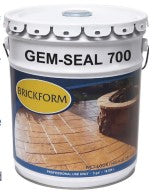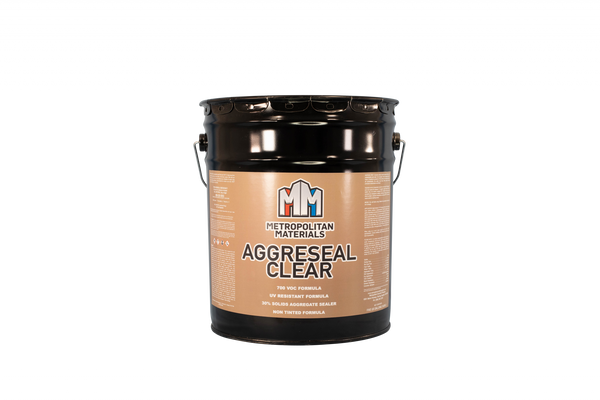Decorative concrete designs incorporating exposed aggregate add aesthetic charm to sidewalks, driveways, patios, lawn edgings, and more. However, no exposed aggregate project is complete without applying a sealer.
A high-quality sealer will accentuate the richness and depth of the pad’s color while also helping protect it from abrasion, freeze damage, dusting, efflorescence, spalling, staining, and more. An outdoor exposed aggregate surface typically needs to be resealed every 3 to 5 years, depending on the wear and tear it endures.
Choosing the right type of sealer for your project is also important, as the wrong sealer can strongly reduce the quality of an otherwise flawless product.
In this blog post, we’ll explore the differences between the various types of exposed aggregate sealers you can use, recommend some of our favorite products, and provide professional application and maintenance advice.
Water- Versus Solvent-Based Sealers
Open aggregate sealers are available in two primary types: water-based and solvent-based While they have some similarities, solvent-based sealers are typically recommended for exposed aggregate projects.
Here's an overview of each type’s characteristics:
Water-Based Sealers
- Contain fewer volatile organic compounds (VOCs) than solvent-based sealers.
- Are not well-suited for many exterior projects.
- Are low-odor and easy to clean up.
- Produce a matte finish.
Solvent-Based Sealers
- Are more difficult to clean up.
- Produce a glossy (wet-look) finish.
- Are much better suited for outdoor applications and not recommended for indoor applications.
- Contain more VOCs.
- Have a stronger odor than water-based sealers.
- Penetrate deeper into the concrete than water-based sealers and provide more vigorous protection.
Clear Versus Colored Aggregate Sealers
Exposed aggregate sealer products can either be transparent or colored. Both types provide similar levels of protection to the aggregated surface; however, the clear type doesn’t change the natural appearance of the concrete and won’t create a sheen. Comparatively, colored aggregate sealers add a hue to the exposed aggregate and produce a semi-glossy, wet-looking sheen, even when fully dry.
Additional Factors to Consider
When choosing a sealer for your exposed aggregate project, you’ll also need to understand and consider:
- How much traffic the area will be regularly exposed to. If the area will receive high foot traffic, you’ll want to look for a high-traffic sealer to prevent wear and tear.
- How much sun the area will receive (full versus partial versus none). If your area is in a full sun location, look for UV- or fade-resistant exposed aggregate sealers.
- Climate conditions (frequency of rain, ice, wind, and temperature fluctuations). Most sealers provide some level of weather resistance. Your climate conditions will determine how often the sealer needs to be reapplied.
- How easy you want the application to be. Water-based sealers are typically easier to apply than solvent-based. However, water-based sealers may not provide the long-lasting protection you need.
Stamped Concrete's Recommendations
Some of our favorite sealers for exposed concrete aggregate include:
Gem-Seal

Brickform Gem-Seal is a high-quality, acrylic solvent-based aggregate sealer formulated to protect decorative concrete surfaces, including colored, stained, stamped, and exposed aggregate concrete. It produces a transparent, non-yellowing, high-gloss finish.
Gem-Seal should be applied, without thinning, when temperatures are between 50 and 85 degrees Fahrenheit and should be allowed to dry at least 24 hours before receiving foot traffic. 72 hours is better, especially for high-traffic areas. Don’t apply Gem-Seal on foggy, rainy, extra-hot, cold, or windy days.
Aggreseal Supreme (Clear/Gray/Brown)

Aggreseal Supreme is a UV-resistant, high-gloss, solvent-based exposed aggregate sealer available in clear, gray, and brown finishes. These acrylic-based, penetrating sealers enhance the concrete’s resistance to intense heat and cold, rain, deicing salt, and stains and produce a wet-looking appearance when fully dried. These sealers also provide excellent adhesion, which will help solidify loose aggregate, enhancing the final product’s safety and durability.
Aggreseal Supreme should only be applied when temperatures are between 50 and 80 degrees Fahrenheit. After applying, allow the surface to dry for at least six hours before using it. If the exposed aggregate surface is a driveway, allow it to dry for at least 48 hours. Lastly, if applying multiple coats, allow it to dry for at least four hours before applying a second coat.
Application & Maintenance Tips
Application Tips
It’s important to be realistic when it comes to DIY projects. It’s easy to watch professionals working and develop a false sense of what you can accomplish on your own. And, in the case of concrete work specifically, small mistakes can stand out like sore thumbs. Plus, once the concrete is cured and sealed, it can be challenging to modify.
If you’re going to apply an exposed aggregate concrete sealer, be sure you:
- Prepare and clean your aggregate surfaces, and allow them to dry thoroughly before applying the sealer.
- Avoid applying concrete sealer on rainy, windy, humid, very hot, or cold days.
- Read and adhere to the manufacturer’s recommended spread rate.
- Use a pump sprayer and a one-half-inch nap roller to apply the sealer.
- Keep moving to apply the aggregate sealer quickly.
- Avoid creating spray overlap and roller marks.
- Avoid walking or sitting on the treated surface until it’s completely dry. Drying times will vary based on the sealer you use—always look at the instructions provided by the manufacturer.
Maintenance Tips
It’s important to reapply sealer every 3 to 5 years. You can extend the time between reapplications by:
- Using a low-to-medium pressure power washer to keep the surface stain-free, clean, and free of weeds and moss.
- Using kitty litter soaked in acetone or lacquer thinner to draw out tough, set-in oil stains.
- Regularly blowing the leaves off the surface and sweeping the surface with a stiff-bristled push broom.
- Keeping the surface free of ice and snow. Avoid using deicing salt—choose a concrete deicer like calcium chloride
Find the Right Aggregate Sealer Today
Stamped Concrete is committed to providing our customers with superior-quality decorative concrete materials, tools, and supplies. Visit our online store to view our exposed aggregate sealers, or contact our pros today if you need help selecting the best sealer.











